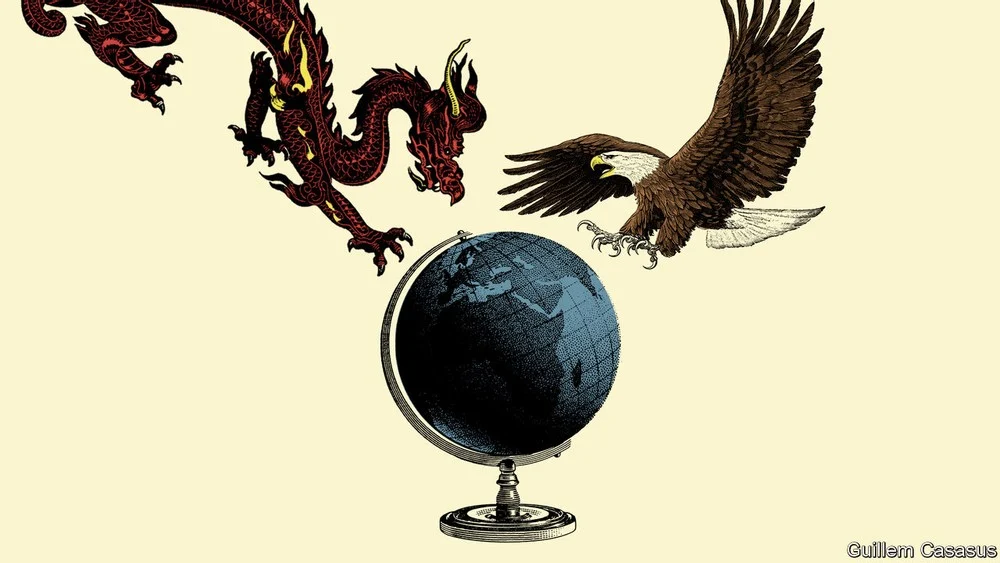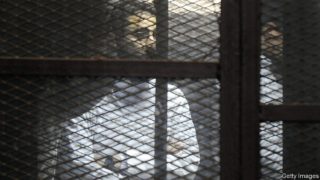IN HIS CLASSIC account of the Peloponnesian War, Thucydides concluded that the conflict was the consequence of growing Athenian power instilling fear in Sparta. In “The Thucydides Trap”, an influential essay published in 2015, Graham Allison of Harvard University examined whether the same dynamic would apply to America and China. He identified 16 historical episodes where an established power’s position was disrupted by a challenger. In 12 of those cases the shift ended in war. A repetition today was not inevitable, he concluded, but escaping the trap “requires tremendous effort”.
Mr Allison’s analysis was studied closely in Washington and Beijing. Nonetheless, in the past five years the relationship between the world’s superpower and its Asian challenger has deteriorated in a manner that suggests few are paying heed to history. Under Xi Jinping, China has become more aggressively assertive abroad and more authoritarian at home. Under Donald Trump and now Joe Biden, American policy towards China has shifted from hubristic faith that it could be integrated into the existing American-led world order to something closer to paranoid containment, marked by suspicion of China’s intentions and a fearful bipartisan consensus that America’s global pre-eminence is at risk.
This growing antagonism has already caused plenty of damage, from the tariff war to heightened tensions over Taiwan. It has enfeebled the global responses to covid-19 and climate change. Unfortunately, as bad as things seem now, they could easily get worse. The world that emerges from the pandemic will be shaped by an adversarial rivalry that is not just about each side’s relative power, but has become an existential competition as each side strives to demonstrate the superiority of its system of government.
Each side is striving to show the superiority of its system of government
Mr Biden has already described it as such, saying that Western democracies are in a “contest” with autocratic governments over which system works better in a rapidly changing 21st century. For Xi Jinping the framing is similar and the evidence already overwhelming: collective state control, he repeatedly asserts, is plainly superior to dysfunctional Western democracy. “The East is rising and the West is declining,” as Chinese officials have become fond of saying.
Events on the global political stage in 2022 will reinforce that view. Starting with the Winter Olympics in February and culminating with the 20th Communist Party congress later in the year, China will stage a series of tightly choreographed events designed to project the competence, clout and all-round superiority of party rule, and formalise Mr Xi’s position at its helm beyond the ten-year tenure that has hitherto been the norm.
Xi who must be obeyed
The party will go to extraordinary lengths to prevent instability or criticism of any kind. The risk of embarrassing protests at the Olympics by citizens of pesky democracies perturbed by China’s “re-education” camps in Xinjiang, for instance, has been addressed by imposing a strict covid “bubble” that does not allow any foreign spectators to attend. On the domestic front, any whiff of disquiet within the party at Mr Xi’s rejection of any term limit for his rule will be met with brutal purges. Officials will celebrate the dawn of a “new era”: that of Mr Xi, in total control of the party for as long as he wishes.
Meanwhile, Western democracies will showcase all their frustrating messiness. In Europe a winter of energy shortages, with high prices and even rolling blackouts, will infuriate voters and frighten politicians. France’s presidential election will be an ugly spectacle of populist demagoguery, the tone set by Eric Zemmour, a hard-right, anti-immigrant television personality who is positioning himself as the French Trump. In the end Emmanuel Macron will probably be re-elected, as the populist right-wing vote splits, but a campaign dominated by resentment and culture wars will not feel like an advertisement for democracy.
The biggest disappointment will be America itself. Mid-term election years are usually ones in which little is achieved legislatively and the party that holds the White House loses seats in Congress. 2022 will be a particularly extreme example of this mid-term curse. Even if he succeeds in getting a version of his “Build Back Better” package of infrastructure and social spending passed, Mr Biden begins 2022 with his popularity still dimmed by rising inflation and supply shortages. With an eight-seat margin in the House of Representatives and a 50-50 split in the Senate, the Democrats are at grave risk of losing control of both. And the Republican Party, wholly in thrall to Mr Trump, has adopted his false narrative that the 2020 election was stolen and has been changing laws, in numerous states where it controls the legislature, to tip election oversight in its favour.
As the year goes on, the near certainty that, health permitting, Mr Trump will be the Republican presidential candidate in 2024 means America’s political debate will be overshadowed by fears of the biggest constitutional crisis since the civil war. Outside America, those who thought Mr Trump an awful aberration will be shaken by the prospect of a comeback.
Meanwhile, in the economic arena…
If the theatre of politics makes Western democracy look dysfunctional relative to Chinese autocracy, 2022 may offer a different verdict on which system delivers the most competent economic management. From tech companies to post-pandemic reopening, China and America are taking starkly divergent approaches to similar challenges. And, for the first time in years, China may make more mistakes.
Mr Xi has embarked on a no-holds-barred effort to cut China’s capitalist titans down to size, erasing as much as $1.5trn in shareholder value with his clampdown on technology companies and imposing tough restrictions on industries, from video-gaming to private tutoring, that are deemed inimical to “common prosperity”. In America, bipartisan fulminations about the corrosive impact of Facebook and other tech giants will lead to little more than Congressional hearings. Market forces, however, will do a better job of delivering change, as younger consumers seek out new platforms and the big tech firms start to encroach on each other’s territory.
America and the rest of the West will move into a living-with-covid mindset. The disease will not disappear, but become endemic. Booster jabs will become the norm, remaining travel restrictions will be relaxed and lockdowns will become a thing of the past. China, by contrast, will stick with a zero-covid policy throughout 2022. Having terrified its citizens about the disease and touted its toughness as a mark of superiority, China’s government cannot easily change course. The country will remain walled off from the rest of the world with long quarantines and sharply restricted travel.
In both of these cases, China’s draconian approach will eventually cause economic damage. Regulatory unpredictability and censorious disapproval of the country’s most successful capitalists will discourage entrepreneurship and hinder innovation. And maintaining a zero-covid policy in a world in which the disease is endemic will require disruptive shutdowns.
All this will complicate China’s already challenging macroeconomic environment. China-watchers have worried for years about the consequences of unwinding the country’s enormous property boom and the jaw-dropping levels of debt that accompanied it. The crisis at Evergrande, a huge developer, suggests that this tricky transition is at last under way. It will dominate 2022 as other property-related firms fail. Add to that structural challenges, from a shrinking workforce to a rapidly growing number of old-age dependents, and the economic pressures are considerable. Annual gdp growth could fall to 5%.
The good news is that a military confrontation seems unlikely
Slower growth in China would cast a shadow across the global economy. But, paradoxically, by dampening commodity prices it would help ease America’s main macroeconomic challenge: the risk of sustained high inflation. That would leave room for the Federal Reserve to stay looser for longer. With covid-19 behind it, its fiscal tightening mostly complete and (assuming some version of Mr Biden’s bill is passed) with a long-overdue effort to improve infrastructure under way, America’s economy could grow smartly, even as its politics frays. gdp growth of 4%, not far off China’s, is plausible.
Divergent political and economic performance will dominate the headlines in the coming year. But won’t that undermine the chances that America and China will make the “tremendous effort” needed to build a functioning relationship? Not necessarily. With a faltering domestic economy, Mr Xi might be keen to improve the trade relationship with America, while Mr Biden, embattled at home, might want to notch up a foreign-policy success before the mid-terms. And in theory the two sides could make progress in plenty of areas, such as devising a sensible deal on trade and technology to replace the tariffs of the Trump era; agreeing on a common approach to cyber-security, nuclear non-proliferation or the militarisation of space; or finding ways to accelerate the clean-energy transition in the wake of the COP26 climate meeting in Glasgow.
Unfortunately, this all seems highly unlikely. In a deeply polarised America, one of the few areas of bipartisan agreement is to be tough on China. Mr Biden will not risk Republican attacks that he is going soft by doing deals, however sensible they might be. And a China that views Mr Biden as a transitional figure in a dysfunctional democracy is more likely to dial up its nationalist propaganda to distract from domestic economic weakness. The good news is that a military confrontation seems unlikely in 2022. The overriding need to preserve stability in the run-up to the party congress will discourage China from adventurism or excessive sabre-rattling, whether around Taiwan or in the South China Sea. The bad news is that the Thucydides Trap will not have gone away.
By Zanny Minton Beddoes: Editor-in-chief, The Economist
THE ECONOMIST





